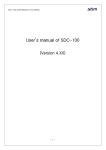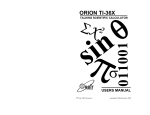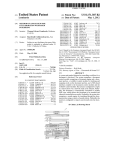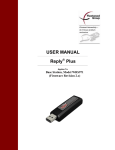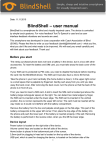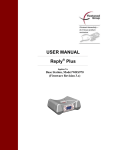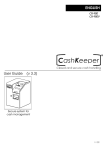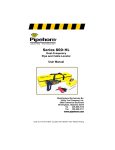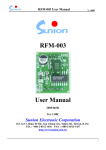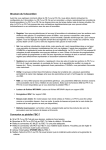Download Users Manual
Transcript
iBill Users Manual Talking Banknote Identifier RBIT RESEARCH 1. Introduction This manual is designed to guide you in the use and care of the iBill Talking Banknote Identifier. This specially designed unit identifies and announces the denomination of U.S. banknotes. 2. Getting familiar with the iBill 2.1 Orientation of the unit and its Controls This section will familiarize you with the location and functions of the controls. Place the unit on a desk or hold it in your hand so that the ridge on one of the two large flat sides of the unit is on the top side and towards you. This is the TOP side of the unit. The ridge forms the opening of the slot for inserting the bill. You will find two identical pushbuttons with small ridges on the right and left sides of the unit. Now turn the unit over so that the BOTTOM side of the unit is facing upwards. You will feel several short ridges about half inch in length. These identify the cover of the battery compartment and allow you to open it easily. 2.2 Replacing the battery The iBill uses a single AAA alkaline battery for operation and is shipped to you with a battery installed. To replace the battery, first open the battery compartment cover on the bottom of the unit. The cover can be identified by a ridged pattern. Open the cover, by pushing it outwards, gently but firmly. The battery cover is held securely to the unit by a rubber string so that it does not separate from the unit and get misplaced. Care should be taken to avoid applying undue force which may tear the rubber strings. -2- Once the battery cover is open, you will find a silk cloth strip which aids in removal of the battery. The old battery can be extracted by pulling on this silk strip. When inserting a battery, this strip should go around the underside of the battery. To insert the new battery, hold the unit so that the battery compartment is open and facing upwards and towards you. First, push in the negative terminal (the flat end of the battery) into the left side of the battery compartment. Then push the other end (positive terminal, with a bump), into the compartment and ensure that the battery is secure. You may now close the cover by sliding it and begin use. For reliable operation of the product, the use of AAA alkaline batteries from reputable manufacturers is strongly recommended. 2.3 Announcement Modes The unit can be operated in one of three modes – Speech, Tone or Vibration. In Speech Mode, the unit announces the denomination of the bill in a female voice. In Tone Mode, the unit announces denominations by a pattern of tones of different pitch and duration. In both Speech and Tone Modes, other indications, such as turn-on or low-battery warnings are in the form of unique tone sequences. In Vibration Mode, the unit announces denominations by a pattern of vibrating pulses of different durations. Other indications are also in the form of vibratory patterns. 2.4 Announcements and Indications The following table describes the announcements and indications the unit provides for various events in each of the Announcement Modes. Event Turning on the unit Speech Mode Tone Output Single short beep -3- Vibration Mode Very short pulse Event Announce $1 bill Announce $2 bill Announce $5 bill Announce $10 bill Announce $20 bill Announce $50 bill Announce $100 bill Un-identifiable bill or no bill inserted Progress of identification Volume level selection in speech mode Tone mode selection Vibration mode selection Speech Mode ”One” ”Two” ”Five” ”Ten” “Twenty” “Fifty” “Hundred” “Error” Tone Output Single beep of low pitch Two beeps of low pitch Three beeps of low pitch Single beep of high pitch Two beeps of high pitch Three beeps of high pitch Four beeps in a low-high-lowhigh pitch pattern Three beeps of different pitch Single short beep of low pitch Vibration Mode Short pulse Two short pulses Three short pulses Long pulse Two long pulses Three long pulses Four pulses in a Short-long-shortlong pattern Very long pulse None Single beep of low pitch, at the set volume level Two short beeps of different pitch Single short pulse First Low Battery Warning Two short beeps of high and low pitch Second Low Battery Warning Four short beeps of high and low pitch Battery too low to operate Three short beeps of different pitch, then the unit turns off -4- Three very short pulses, after bill is announced Three very short pulses, after bill is announced Three very short pulses, then the unit turns off 3. Using the iBill 3.1 Identifying a Bill To switch on the unit, press either of the two push-button switches. Turnon is indicated by a short beep or vibration pulse. The unit begins the identification process and when complete, announces the denomination of the bill (or indicates an un-identifiable bill). The button may be released any time after the turn-on beep (or pulse), or may be kept pressed to change the mode or volume as described later in this manual. Once turned on, the unit immediately begins the identification process. The bill should therefore be fully and properly inserted into the slot before pressing one of the buttons to turn on the unit. The bill should be inserted so that the short side of the bill is parallel to the slot. Proper insertion is achieved when the bill cannot be pushed inwards further with a light force. The inserted bill should be held firmly in the slot when the button is pressed. The bill may be removed once the unit acknowledges the button press with a beep or vibration pulse. If there is no beep or vibration indication upon pressing one of the buttons, it is likely that the battery is too weak and should be replaced. The unit will identify most bills within one second. However, if the bill is in poor condition, it may require more time for identification. The unit indicates the progress of the identification process by means of a short, low-pitched beep. In Vibration Mode, the unit does not provide indication of the progress to avoid confusion. If a bill is in poor condition and cannot be identified within one second, a beep is emitted after one second and the unit continues the identification process. If the unit fails to identify the bill, it announces an Error after 3 seconds. In this event, the bill should be inserted in a different orientation. If you choose, you may remove the bill and insert it in a different orientation at any time, and identification can be restarted by pressing either one of the buttons. If either of the buttons is held continually pressed, identification progress tones are suppressed. If a volume or mode change operation is -5- performed, the denomination of the bill is announced when both buttons are released. The unit turns itself off automatically after completion of bill identification or a volume or mode change. 3.2 Canceling the current identification cycle Once the identification cycle has begun, you may wish to cancel the current cycle and restart it due to several reasons, for instance, realizing that the bill was not properly inserted, or if the identification is taking long due to poor condition of the bill. The bill can simply be re-inserted and identification re-started by pressing one of the buttons. Upon pressing the button, the unit indicates the start of identification just as in the case of normal turn-on, by providing a beep or vibration pulse. 3.3 Changing the Output Mode and Volume Level The unit provides three output modes: Speech, Tone and Vibration. Three volume levels are available in the Speech output mode. The modes and volume levels are selected by using both push-buttons together. The loudness of the tones in tone mode is fixed and cannot be increased or decreased. It will decrease at low battery levels automatically to extend the life of the battery. Pressing and holding any one button, and then pressing and releasing the other button changes the volume or mode. Each time the second button is pressed and released, the Output Mode setting cycles between Speech Mode volume levels 1, 2, 3, Vibration Mode and Tone Mode, and then back to Speech Mode volume level 1. A tone of appropriate volume is emitted at each volume setting to indicate the level chosen. For the Tone Mode, a double-tone of different pitch is emitted. For the vibration setting, a short vibration pulse is emitted. The Output Mode and volume level can be changed at any time while the device is turned on, even while the unit is in the identification process. The unit continues the identification process upon completion of the mode or volume change. If either one of the buttons continues to remain pressed after the mode or volume change, the unit will wait until it is released before continuing operation and announcing the denomination. -6- 3.4 Low Battery Indication The unit continually monitors the battery level during use. A warning is provided when the remaining capacity of the battery reaches approximately 10% of the full capacity. The warning is in the form of two short beeps of high and low pitch in Speech and Tone Modes or three very short vibration pulses and is provided at the end of each denomination announcement. When the remaining capacity of the battery reaches approximately 5% of the full capacity, the warning tone changes to four short beeps of high and low pitch at the end of each denomination announcement. In Vibration Mode, this warning is in the form of three very short vibration pulses. The 5% and 10% warnings are the same in vibration mode. If the battery level is deemed to be critically low and insufficient to permit accurate operation, the unit emits 3 short beeps of different pitch or three short vibration pulses and shuts itself off. This can happen when the unit is first switched on or when the volume or output modes are changed. If one of the buttons is kept pressed when the battery is critically low, the unit will emit an intermittent series of beeps. You should not attempt to operate the unit once it starts giving critical low-battery warnings and should immediately replace the battery with a fresh one. Battery Warning and Volume Level Battery life and low battery warning signals are highly dependent on the output mode and volume level at which the device is being operated. You may therefore get low-battery warnings at volume level 3 for instance, but if the volume level is adjusted to lower levels, the warnings may stop. This is because higher volume levels and Vibration Mode consume more power When the battery weakens, the unit will automatically reduce the volume level in Speech Mode to allow continued use and to extend the life of the battery. Therefore, even if you attempt to set a higher volume level, the unit will limit the volume to the maximum level possible with the weak battery. To restore full volume, the battery must be replaced. -7- 4. Care of the device The unit should be protected from dust and liquids. When not in use, keep the unit in a protective water and dust-proof case. Periodically wipe the unit with a slightly damp, soft, lint free cloth to remove accumulated dust, especially from the area near the bill insertion slot. 5. Troubleshooting If you encounter difficulty in using the device, it might be due to one of the following reasons. 5.1 The unit does not turn on If you are not able to turn on the unit by pressing one of the buttons, the battery should be replaced. You should also check and confirm that the battery is inserted correctly. 5.2 After turning on, the unit turns off without announcing the result If the unit turns off abruptly without announcing the result, the battery is weak and should be replaced. If the unit gives progress beeps but doesn’t announce the result within 3 seconds after turning on, this also indicates that the unit turned off due to a weak battery. 5.3 The unit is not able to identify the bill 1. Try inserting the bill in a different orientation. Often one corner of the bill may be damaged but other corners might be fine. 2. Try inserting the bill in a slightly different position in the slot, by pushing it a little bit towards one of the two sides of the slot 3. Check to make sure that the corners of the bill are not folded during insertion. If the corner being inserted does have a fold, unfold it and try again, or insert a different corner. 4. Ensure that the bill is not moved during the identification process. -8- 5.4 The unit does not announce the denomination The denomination is not announced by the unit if either of the buttons is kept pressed after a volume or mode change operation. Once both buttons are released, the unit will announce the denomination. 6. Warranty and Repair Orbit Research provides a one-year limited warranty for the iBill Talking Banknote Identifier from the original date of purchase. The warranty covers all manufacturing defects as well as all parts and related workmanship. During this period Orbit Research will repair or, at its discretion, replace the unit at no cost to the customer. The customer will be responsible for shipping the unit and all accessories to Orbit Research and bear the cost of shipping. Proper insurance during shipment is strongly recommended. For valid warranty claims, Orbit Research will pay the return shipping charges. It is incumbent upon the customer to provide proof of the purchase date (in the form of the original receipt) at the time when a warranty claim is made. Please contact Orbit Research for a Return Authorization Number prior to sending the unit for repairs. The warranty is void if the unit has been damaged by accident, misuse, neglect or improper service and does not apply in cases where the unit has been opened or in any way altered by an unauthorized person. Repair After Expiration of Warranty Following the warranty period or in case of damage not covered by the limited warranty, Orbit Research will make reasonable efforts to repair the unit. Shipping charges, both ways, will be borne by the customer in this case. Disclaimers: Orbit Research will not be responsible for any direct or indirect consequences following the utilization of the iBill Talking Banknote Identifier. -9- Orbit Research reserves the right to change product specifications without notice. Any modifications or upgrades to products previously sold will be performed solely at the discretion of Orbit Research. The latest version of this user guide can be found at the Orbit Research website www.orbitresearch.com. - 10 - iBill User Manual Version B © Orbit Research Orbit Research 3422 Old Capitol Trail, Suite 585 Wilmington, DE 19808 1-888-606-7248 www.orbitresearch.com RBIT RESEARCH - 11 -












